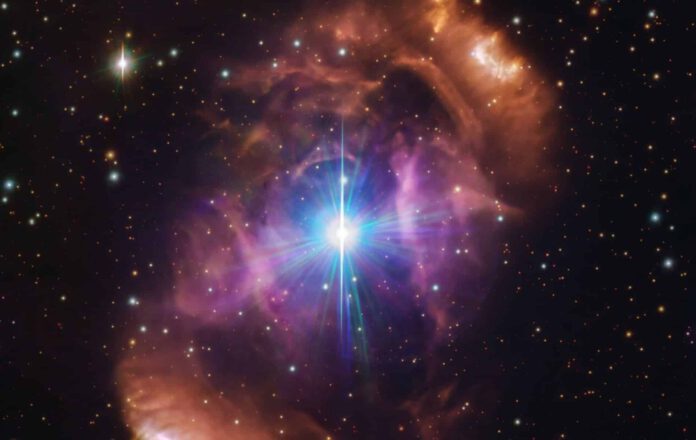
The nebula itself, in addition to the two stars contained within, has left astronomers awe-struck. Their characteristics are not what initially expected, yet recent research has indicated a compelling reason for this circumstance. The enigmatic nebula is believed to be the result of a riveting event: a colossal collision between two stars.
Article Details
This information has been covered in a recent paper published in the journal Science. The study examines the HD 148937 system, part of the Norma (Carpenter’s Square) galaxy, around 3800 light years away from Earth. The system includes two heavyweight stars, surrounded by a stunning nebula: a cloud comprised of gas and dust. According to researcher Abigail Frost, a nebula surrounding two heavyweight stars is quite rare. This peculiarity led her to believe that something intriguing must have occurred within this system. And further examination of the data only reinforced this suspicion.
The Peculiar Stars
Typically, paired stars mirror each other. However, the case with HD 148937 is—much to the surprise of astronomers—quite distinctive. One star appears to be at least 1.5 million years younger than the other; and contrary to its partner, this younger star is magnetic. Frost commented on the oddity, saying after a detailed examination, the conclusion was that the heavier star appears much younger than its companion, which makes no sense given they should have been formed simultaneously!
In addition to the perplexing stars, the nebula poses its own set of mysteries. Further analysis of the nebula indicates that it is merely 7500 years old, thus hundreds of times younger than the stars, and contains abundant nitrogen, carbon, and oxygen—elements typically found deep within stars, not outside.
Solving The Riddles
Though the nebula is shrouded in mysteries, researchers have proposed a potential theory to account for these abnormalities, as explained by researcher Hugues Sana. The researchers suggest that the system originally consisted of a minimum of three stars. At some point, two of them must have drawn very close to each other, while another star stood at a more significant distance. The two innermost stars then merged to form a magnetic star, resulting in some material being hurled away to form the nebula. The more distant star migrated to a new orbit around the newly merged magnetic star, thereby creating the double star formation we currently observe in the heart of the nebula.
Useful Tools: The Very Large Telescope
This proposed theory was achieved using ESO’s Very Large Telescope to study the nebula. Researcher Laurent Mahy explains the discovery of an age difference between the stars suggesting the proposed scenario was the most plausible. Such conclusions could only be drawn with the aid of the new ESO data.
Solving Another Stellar Mystery
This research not only unravels the mystery surrounding this specific nebula but also seems to offer a solution to a more universal stellar enigma: how some heavyweight stars acquire a magnetic field. Although magnetic fields are common amongst lightweight stars (like our sun), this is not typically expected amongst more heavyweight stars, as they lack the ability sustaining a magnetic field in the same way lightweight stars can. However, heavy, magnetic stars have been discovered in the past. Astronomers speculated that these hefty stars obtained their magnetic fields as the result of a merger of two stars. However, evidence to support this theory was lacking until now—HD 148937 presents compelling evidence supporting this hypothesis. Frost considers ourselves fortunate to have witnessed this, as magnetism in massive stars rationally doesn’t persist in relation to the star’s lifespan. It seems we were able to observe this rare event shortly after it occurred.
The investigators plan to continue analyzing the nebula and its contained stars, hoping that the future construction of the Extremely Large Telescope will allow for a more detailed analysis. Their future explorations are not preemptively concluding that no further surprises will be encountered.











